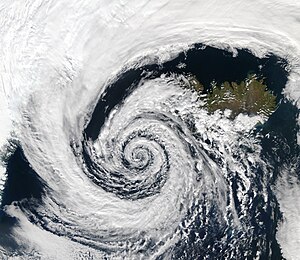
Back Sikloon Afrikaans चक्रबात ANP إعصار Arabic Ciclón AST Siklon Azerbaijani Цыклон Byelorussian Циклон Bulgarian चक्रवात Bihari ঘূর্ণিঝড় Bengali/Bangla Cicló (meteorologia) Catalan

In meteorology, a cyclone refers to any low pressure area with winds spiraling inwards. Cyclones rotate clockwise in the Southern Hemisphere and anti-clockwise in the Northern Hemisphere. A cyclone is the general term for a variety of low pressure system types, such as tropical cyclones, extra tropical cyclones and tornadoes.
The largest of these systems are extratropical cyclones and cold-core polar cyclones which lie on the synoptic scale with a horizontal length of 1000 km or more. The warm-core cyclones are the tropical cyclones, mesocyclones, and the polar lows that lie within the smaller mesoscale. Subtropical cyclones are intermediate in size. Cyclones have also been on other planets outside of Earth, such as the Great Red Spot of Jupiter and the Great Black Spot of Neptune.
Cyclones are also referred to as hurricanes and typhoons (depending where do they form). They consist of the eye, eyewall and rainbands.
The process of cyclone formation and intensification is described as cyclogenesis. The formation of extratropical cyclones comes as waves in large regions of enhanced midlatitude temperature contrasts which are called baroclinic zones. These zones contract to form weather fronts as the circulation of the cyclone closes and gets more intense. Later in their life cycle, cyclones form what is called an occluded front. The cyclone's track is then guided over the course of an 2 to 6 day life cycle by its steering flow of the polar or subtropical jetstream. Cyclones destroy many things when they come into contact with land such as crops, buildings, trees, etc.